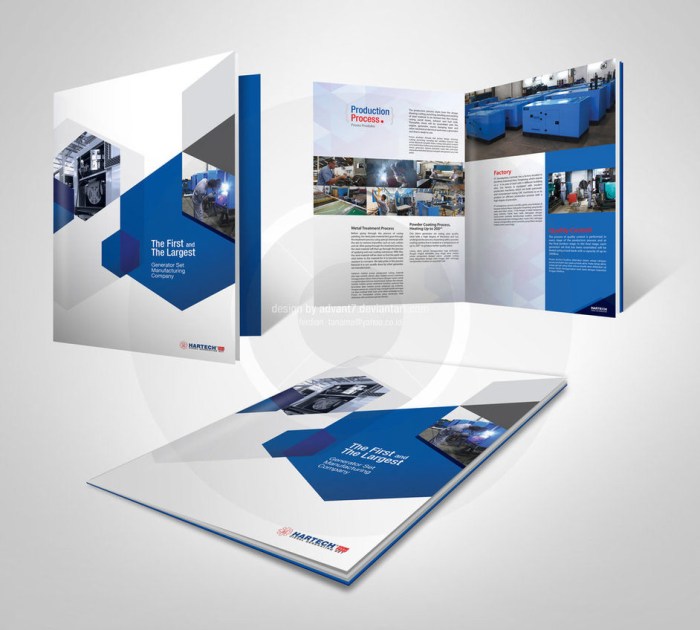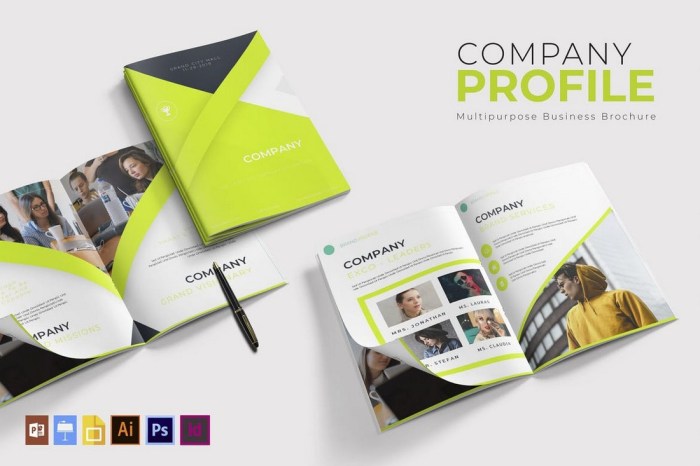Visual Elements and Branding in Company Profile Design: Contoh Desain Company Profile Bagus

Contoh desain company profile bagus – A company profile serves as a crucial first impression, and its visual elements are paramount in conveying brand identity and attracting potential clients or investors. Effective design utilizes color palettes, imagery, logo placement, and consistent branding to create a memorable and professional presentation. The successful integration of these elements reinforces brand messaging and establishes a strong visual identity.
Color Palette and Brand Personality
The strategic use of color significantly impacts brand perception. Different colors evoke various emotions and associations. For instance, blues often represent trust and stability, making them suitable for financial institutions or technology companies. Greens convey growth and environmental consciousness, appealing to eco-friendly businesses. Reds stimulate energy and excitement, ideal for brands in the food or entertainment industries.
Yellows project optimism and creativity, fitting for companies in the arts or education sectors. A well-chosen palette should align with the company’s values and target audience, consistently reinforcing the brand message throughout the profile.
Imagery to Convey Brand Values
High-quality imagery is essential in creating a lasting impression. For example, a technology company might use an image of a clean, minimalist workspace with sleek, modern equipment, emphasizing innovation and efficiency. The composition would likely feature strong lines and geometric shapes, with sharp, bright lighting to highlight the technology. Alternatively, a sustainable agriculture company might feature a photograph of lush, vibrant fields bathed in warm, natural light, showcasing healthy produce and emphasizing organic practices.
The composition might use a shallow depth of field to focus on the produce, while the natural lighting creates a sense of authenticity and purity. In both instances, the imagery directly reflects the company’s core values and aspirations.
Logo Placement and Visual Hierarchy
The logo is the cornerstone of brand recognition. Its placement and size within the company profile should reflect its importance. It should be prominently displayed on the cover page and potentially repeated subtly throughout the document. However, it should not overpower other essential information. A well-designed visual hierarchy ensures that critical elements like the company name, mission statement, and key services are easily accessible and visually prominent.
Crafting a stunning company profile design is key to making a memorable first impression. Think about the visual impact – a captivating design can elevate your brand significantly. For instance, consider the atmosphere you’d want to convey, much like the inspiring examples of contoh desain cafe musik which showcase creative space planning. Ultimately, a well-designed company profile, much like a beautifully designed cafe, speaks volumes about your brand’s personality and professionalism.
This hierarchy guides the reader’s eye through the profile, creating a logical and engaging flow of information. The logo should be easily recognizable and consistently sized and styled across all pages.
Consistent Brand Identity Across Visual Elements
Maintaining consistency across all visual elements is critical. This includes consistent use of fonts, colors, imagery style, and logo placement. A style guide should be developed to ensure that all visual elements align with the brand’s identity. This guide will serve as a reference for all design materials, ensuring a cohesive and professional presentation. Inconsistent branding can confuse the audience and weaken the overall impact of the company profile.
By maintaining visual consistency, the company establishes a strong and recognizable brand identity.
Company Profile Cover Page Mock-up
Imagine a cover page featuring a clean, minimalist design. The company logo is centrally placed at the top, rendered in high-resolution with a subtle, embossed effect. Below the logo, the company name is displayed in a bold, elegant font, followed by a concise tagline that encapsulates the company’s mission. The background is a subtle gradient of two complementary colors from the company’s brand palette, providing a sophisticated yet understated backdrop.
High-quality, relevant imagery, possibly an abstract representation of the company’s core business, is subtly incorporated in the background, adding visual interest without distracting from the primary textual elements. The overall effect is clean, professional, and memorable, immediately communicating the company’s brand values and aspirations.
Structure and Layout of a Company Profile

The effective structure and layout of a company profile are crucial for conveying a professional image and ensuring clear communication of key information to target audiences. A well-designed profile facilitates easy navigation and comprehension, leaving a lasting positive impression. Different layouts cater to varying needs and lengths of content.
Comparison of Company Profile Layouts
The choice between single-page, multi-page, and booklet formats depends on the complexity of the information and the intended audience. A single-page profile is ideal for concise information, often used for quick overviews or introductory materials. This format necessitates brevity and prioritization of key details. Multi-page profiles allow for more comprehensive coverage, incorporating detailed sections on history, services, and team members.
Booklets, typically used for more substantial profiles, offer a professional and tangible presentation, ideal for formal introductions or client presentations. They provide ample space for visual elements and detailed narratives.
Sample Table of Contents for a Multi-Page Company Profile
A well-structured table of contents significantly enhances navigation. The following example illustrates a potential structure for a multi-page company profile:
| Page | Section | Subsection | Content |
|---|---|---|---|
| 1 | Introduction | Company Overview | Mission, Vision, Values |
| 2 | Our History | Milestones | Key achievements and growth |
| 3 | Services | Service 1 | Detailed description and benefits |
| 3 | Services | Service 2 | Detailed description and benefits |
| 4 | Team | Leadership | Bios of key personnel |
| 5 | Client Testimonials | Success Stories | Positive feedback from satisfied clients |
| 6 | Contact Information | Location and Details | Address, phone number, email |
Utilizing Headings, Subheadings, and Visual Cues
Effective use of headings (H1, H2, H3) and subheadings creates a hierarchical structure, guiding the reader through the content logically. This improves readability and allows for quick scanning of key information. Visual cues, such as bullet points, icons, and color-coding, further enhance comprehension and engagement by breaking up large blocks of text and highlighting important points. For instance, using a distinct color for key figures or achievements can draw the reader’s eye.
Visual separators between sections can also improve clarity.
Effective Use of White Space
White space, or the empty areas around text and images, is crucial for creating a clean and uncluttered design. It prevents the page from feeling overwhelming and allows the reader’s eye to rest. Sufficient margins, spacing between paragraphs, and strategic use of negative space significantly enhance readability and visual appeal. A cluttered design can lead to reader fatigue and a negative perception of the company.
Step-by-Step Guide to Creating a Visually Appealing Company Profile, Contoh desain company profile bagus
1. Define Objectives
Clearly articulate the purpose and target audience of the company profile.
2. Content Gathering
Collect all necessary information, including company history, services, team details, and client testimonials.
3. Structure and Layout Selection
Choose a layout (single-page, multi-page, booklet) based on content volume and target audience.
4. Content Organization
Structure the content logically using headings, subheadings, and visual cues.
5. Design and Visual Elements
Select a consistent design theme, incorporating appropriate fonts, colors, and imagery. Maintain brand consistency throughout.
6. White Space Management
Ensure sufficient white space for improved readability and visual appeal.
7. Proofreading and Review
Thoroughly review the profile for errors in grammar, spelling, and factual accuracy.
8. Finalization and Distribution
Prepare the final version in the chosen format and distribute it through appropriate channels.
FAQ Compilation
What are the legal considerations when designing a company profile?
Ensure accuracy in all claims, comply with data privacy regulations (GDPR, CCPA etc.), and obtain necessary permissions for using images and testimonials.
How can I measure the effectiveness of my company profile?
Track website traffic from profile links, monitor social media mentions, and analyze lead generation data to assess its impact.
What is the optimal length for a company profile?
It depends on the context. A concise single-page profile might suffice for online use, while a more detailed multi-page document might be necessary for formal presentations.
How often should a company profile be updated?
At least annually, or more frequently if there are significant changes to the company’s mission, services, or achievements.

